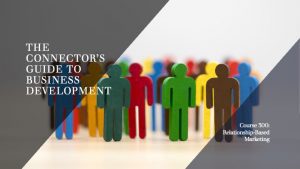How to Identify Leads
A lead is a person with the budget, need, and authority to buy from you during their current purchasing cycle. Most marketing and many sales activities engaged in by sellers are designed to identify or generate leads. There are third-party leads and first-party leads. Third-party leads are those acquired from others and first-party leads are those generated organically.
Third-Party Leads
Often, we rely on others to send us leads. However, third-party information is of questionable quality. Take, for example, purported leads received through Google or other search engines. Both the broadness of the search terms and the placement of the ad link cause the search results to encompass searchers who are not ready to or sometimes even interested in buying.
Case in point, perhaps you designate the following terms to generate search results: “estate planning” “lawyer” and “heir property.” Google will add your firm name and the name(s) of a competing firm(s) to your list of search terms the algorithm uses to identify leads for your business.
Now assume someone searches Google for legal battles over heir property. That search will likely pull up your firm toward the top of the search results. However, the searcher is likely someone wanting to read about fights over celebrity estates such as Whitney Houston’s, Prince’s, or BB King’s. People looking for socialites and heirs like Paris Hilton also will see your website in their search results. You’ll get folks looking for a real estate lawyer, too, because the words lawyer and property are part of your search algorithm. Alas, none of those searchers are leads (even though the search engine will bill you for their clicks).
Further, search engines place the ad link to your site at the top of the search results—even above the organic listing of your site. Therefore, folks that search for your website by name but who want to read a blog post, apply for a job or simply read your content to compete with you for business will be reported as leads as well. But you won’t be able to convert any of them because those searchers have no intention, whatsoever, of buying from you.
Therefore, you must sift through the information dump you receive from a lead generation tool to identify the actual leads within that haystack. The sifting through process is called lead qualification. Read our post entitled “How to Qualify Leads” for guidance on the lead qualification process.
Organic Leads
Organic leads are different because you control what is captured as a lead. Don’t look everyplace for leads. Look in target-rich environments where your leads are likely to congregate.
So, if your ideal client is a wealthy person planning for the distribution of his or her property, think through where that person lives online and offline. What does she read, watch, and listen to (e.g., fashion blogs, fashion magazines, travel shows, travel magazines, Realty TV)? With whom does she interact personally and professionally (e.g., CPAs, financial planners, travel planners)? Where does she go (e.g., high-end department stores, Michelin starred restaurants, church)? What are her worries and values?
Answering those questions will lead you to a client profile. Once you have an accurate profile of your ideal client, you are ready to select the appropriate lead generation tools to reach only the universe of people and companies that are likely to buy from you.
You may be thinking you don’t have time to cast such a narrow net. However, it really is just a matter of when, not whether you want to do the work. With organic leads the work is done upfront. With third-party leads the work is merely delayed.











No responses yet